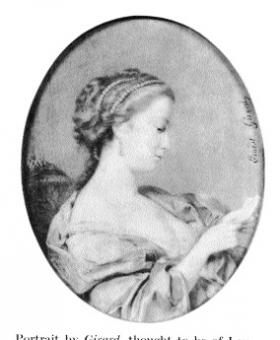‘The Nun’s’ story
Published in 18th–19th - Century History, Issue 3 (Autumn 2004), News, Volume 12
Portrait thought to be of Laura Bell by E. Girand. (Wallace Collection)
BELL, Laura Eliza Jane Seymour (1829?–1894), was the daughter of Robert Bell of Bellbrook, near Glenavy, Co. Antrim, a bailiff for the Hertford estate. In later life she claimed to be a granddaughter of Francis Seymour, 3rd marquess of Hertford, and also that her mother had been rescued from a Spanish convent. She worked in a draper’s shop in Belfast, and unsuccessfully tried acting there and later in Dublin and London. Bell was a strikingly beautiful and vivacious woman, a demi-mondaine who modelled for artists and whose likeness as ‘The Nun’ sold thousands of photographs. She is said to have been the most beautiful woman of her day, and may have been Edwin Landseer’s mistress. She was abandoned in Paris in 1850 by the Nepalese ambassador to London, and on 21 January 1852, in St George’s, Hanover Square, London, she married Augustus Frederick Thistlethwayte, who was just 21 years old, a grandson of a bishop of Norwich. Six months later she ran off with his much wealthier younger brother, Arthur Henry Thistlethwayte, an army officer, who fought at the battle of the Alma (1854) in the Crimea and died at Scutari. Realising that her legal husband, a serious and religious man, had inherited the family’s wealth, she experienced a sudden conversion and returned to him. The couple lived unhappily in Grosvenor Square, London; Augustus Thistlethwayte is said to have been moody and irascible, often firing a revolver to summon servants. Laura, despite her past reputation, was accepted for a time by the Welbeck Street clique of society evangelicals. They eventually found her out in many untruths, including the story about the marquess of Hertford. Undaunted, she took up public preaching in Edinburgh and in London at the Polytechnic in 1865, and was able to maintain her reputation for evangelical witness and philanthropy. In the 1870s and 1880s her ‘dinners to statesmen’ were very fashionable, attended by the Russian ambassador and other notable people, including Lord Rosebery and W.E. Gladstone. Gladstone was fascinated by her own version of her life story and by her company; he visited her often in London and at her country house, and there was some contemporary comment about their relationship, which lasted from about 1864 until her death. She was an extravagant hostess, and her husband regularly announced that he would not be responsible for her debts; on 7 August 1887 Laura found him shot dead in his bedroom. In somewhat reduced circumstances, she gave up the house in Grosvenor Square and moved to a rented property in Hampstead, which was still large enough to support pet deer. She died, childless, at Woodbine Cottage, Hampstead, on 30 May 1894, leaving instructions that her coffin should bear her name as Laura Eliza Seymour. After her death Gladstone’s solicitors retrieved his letters to her, and Gladstone himself burned her letters to him, for fear of their being misunderstood.
















